Table of Contents
While concentrating the galena in the lead ore produced from the Central mine, a valuable by-product was obtained in the form of slime assaying 18% lead, 20% zinc, and 16 oz. silver per ton. This came from an ore in which quartz and rhodonite were the chief gangue-minerals. In the course of ordinary operations, it had long been observed that a froth was formed containing high metallic values, in silver and lead particularly, whenever conditions were favorable, as, for instance, where the rotation of trommels, or the splash of the elevators or raff-wheels, or the motion of the jig-plungers, produced a violent agitation of the mill-water containing slime. Early in 1901 a series of experiments was carried out for the purpose of reproducing and accentuating the conditions responsible for this valuable float concentrate. Experiments and tests, extending over several months, were made on slimes of varying degrees of fineness. Among the appliances tried was a series of funnel-shaped vessels with the small ends downward, each fitted with an overflow-lip. The bottom end of the funnel or cone-shaped vessel was fitted with a tap or plug discharging the contents into the next vessel in the series, and so on. To each vessel was attached, near the bottom, a water-pipe, as well as a pipe carrying compressed air. The object of the water was to provide an upward current for the contents of the vessel, while the object of the compressed air was to produce agitation, and enhance the agitation effect of the up-current of water, in the expectation of reproducing the conditions causing the ‘float’ or metallic froth. Speaking generally, these experiments were on the lines of a spitzkasten, with a strong up-current to produce an agitation of the slime-water, assisted by jets of compressed air. It was thus early recognized that the bubbles of froth noticed in the wet-concentration operations were due to the aeration produced by violent agitation, resulting from mechanical implements moving rapidly in water. In these experiments a metallic froth or scum could be produced and recovered assaying 26 oz. silver, 30% lead, and 22% zinc. The appliance employed is illustrated in Fig. 19.
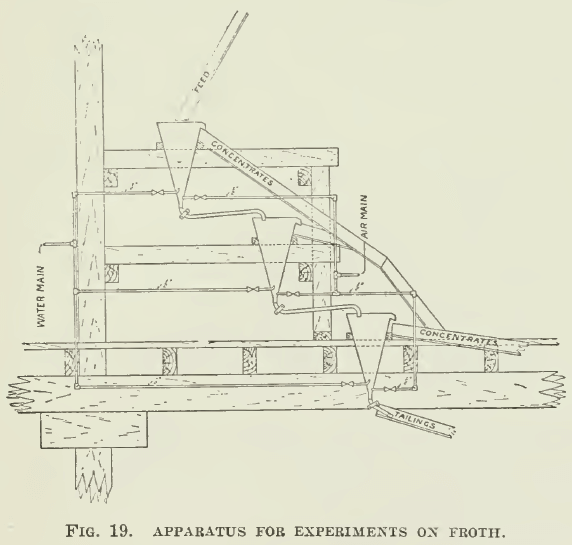
Fig. 19. Apparatus for experiments on froth.
Up to that time the lead concentrate was the only marketable product from the ordinary water concentration. Besides calcite, the ore contained a good deal of rhodonite and garnet, each of which has a specific gravity close to that of blend. Thus water concentration could only yield a quartz tailing and a lead-zinc-rhodonite-garnet middling.
PRELIMINARY TEST
Early in 1903 an exhaustive series of laboratory tests was made on the lead by-product by flotation methods, using heated sulphuric acid and salt-cake solution. These tests yielded some slight measure of success on material specially prepared, that is, on grainy material from which both the coarse and fine had been eliminated, leaving it evenly sized. Certain classes of the material produced by our mills contained such a large proportion of carbonates—such as carbonates of manganese, lime, and lead— that no flotation could be secured except by a prohibitive consumption of acid. These tests were carefully made, but the best work done in the laboratory was not equal to that being secured on a commercial scale in the existing magnetic plant. The tests on these flotation methods were conducted in pans or vessels worked on the principles of spitzkasten, following the lines of Potter and Delprat. The first apparatus was constructed so that the liquors could be raised in temperature by the application of direct heat underneath the pan; but in the later types the temperature of the liquor in the pan or spitz-box was maintained by the injection of live steam into the storage-tank. In none of these tests was agitation employed, the material to be treated being fed practically dry on the surface of the liquor in a regular stream, and the heated liquor added through a pipe discharging near the bottom of the vessel, and given an upward inclination in order to produce an up-current in the box itself and a gentle overflow at the lip. A still surface was imperative in this operation, and it was equally evident that the operation depended largely for its success on surface tension of the liquor, after the gas evolved by the action of the acid on the mineral carbonates had raised the particles. This surface tension was increased by the density attained in the one case by the salts formed from the mineral and gangue through the action of the sulphuric acid, and in the other by the addition of salt-cake. In all these experiments the liquor was returned by the ordinary type of air-lift, using compressed air at about 70-lb. pressure. These experiments definitely demonstrated:
- That there was a limit to the size of the particle that could be buoyed up.
- That any material below a certain size, no matter what its character—whether gangue or mineral—floated, owing to the density of the solution.
- That if the finer particles of gangue were not eliminated before treatment they would be floated with the mineral, and lower its value in metals to such an extent as to make it unmarketable.
Slime, whether existing as a by-product of the ordinary wet-mill concentration or subsequently produced in preparing tailing for treatment, bulked so largely among the total material available for re-treatment that any process that failed in this direction was too limited in its scope to be of much value to the Central mine.
As far as any process up to date was concerned, slime had to be regarded as of no value except in so far as it was available for smelting. The Broken Hill Proprietary Co. had used a considerable quantity in this way, and had discovered that roasting or sintering the slime in open heaps after briquetting gave a fair product valuable for smelting, a good deal of the sulphur and a fair proportion of the zinc having been driven off. The Sulphide Corporation also sought to make its slime available by this means, but it was proved that the losses of metal were too great to justify this method of rendering the slime amenable to direct smelting.
CATTERMOLE OR GRANULATION PROCESS
The foregoing experiments were abandoned on account of information received from London. C. F. Courtney, who was in England during the year 1902, advised that a discovery of considerable importance had been made; that laboratory trials gave every indication of success on a large scale; and that the process was so comprehensive as to include the finest slime and varying coarser sizes of particles up to ½ mm. diam. This was subsequently known as the Cattermole or granulation process, and consisted in the agitation of a mixture of pulp, oil, and water, containing a suitable acid, or an alkali with soap or other emulsifying agent, so as to agglomerate the oil-coated particles into granules. The oil was thus employed in a state of emulsion in water in the presence of an emulsifying agent, such as soap. After agitation the mixture was passed into an up-current separator or classifier to remove the lighter non-oil-coated particles from the agglomerated masses of oil-coated particles. The lighter sand having been eliminated, the pulp passed to a second series of agitators to increase the size of the granules, and thence to a second classifier for the removal of the heavy sand. From the bottom of this second classifier some granulated concentrate was recovered, but the heavy sand from the overflow also carried over, with the up-current, a large amount of granulated mineral. This mixture of granulated mineral and heavy sand passed then to a third series of agitators, and thence to a shaking table, where the granulated mineral, rendered more buoyant by directing jets of compressed air onto the surface of the moist pulp, was buoyed to the surface of the water and floated off the bottom of the table, while the gangue sank and was delivered over the end of the table.
In order to give this process a thorough trial, a model plant was sent from England and erected on the mine early in 1904. G. A. Chapman was specially appointed to conduct experiments with this plant, and started a long series of tests early in June of the same year. It was quickly demonstrated that the process was capable of making high recoveries of all the three metals from the very finest slime, whether taken from the current work of the mill or from old accumulations, and also that old tailing or new crude ore were amenable to treatment when crushed to a given fineness. The largest size of particle that could be recovered was ascertained to be about ½ mm., thus confirming the London work; but it was found that results improved with a decrease in size to impalpability.
In the early tests by Mr. Chapman, emulsions of the heavy oil of petroleum were used, but the cost was excessive, and it was found impossible to treat slime successfully. Emulsions of fatty acids, and also soft soap, were then tried, but proved prohibitive as to cost, except in the case of oleic acid. Oleic-acid emulsion was found to act rapidly and effectively on crude ore as well as on all lead by-products, including slime.
Mr. Chapman’s work on oils and the results obtained by him with the model plant using the granulation process were satisfactory, but it was thought wise to have these confirmed by an independent chemist, and therefore J. C. Moulden, the company’s chief metallurgist at Cockle Creek, was called in, repeated the experiments, and amply confirmed Mr. Chapman’s work. Later it was found possible also to reduce the quantity of oleic acid, as was proved by the following tests in December 1904:
Material used was crushed tailing mixed with slime.
Test No. 1. 3.5% oleic acid on mineral and 0.75% sulphuric acid circuit.
The cost of emulsion in this case was 10s. per ton of ore, but the results were excellent, the concentrate being recovered as partly granulated and partly float or froth.
In test No. 2, only 0.75% of oleic acid with the same (0.75%) sulphuric acid circuit, in which case the cost of emulsion amounted to 2s.3d. per ton of ore, the results being excellent, with all float concentrate, no granular material being formed. This test took considerably longer in agitation.
ERECTION OF LARGE PLANT
Mr. Chapman’s tests, and their confirmation by Mr. Moulden, established the fact that a process was obtained that would, with suitable arrangements for crushing, efficiently handle the whole of the by-products of the wet mill, including slime. It was accordingly decided to erect a plant on the lines of the model, with slight modifications as dictated by experience, capable of treating 100 tons per day, operating on a commercial scale.
It was clear, from experiments and observations, that the time of agitation was a factor in the aeration and oiling of the mineral particles. Therefore, reckoning from the size and capacity of the mixers in the model plant, a mixer was built of the following dimensions: 5 ft. deep and 3 ft. diam., with a wooden stirrer 2 ft. 6 in. diam. at bottom placed vertically and made to revolve at the rate of 350 r.p.m.
Experiments with this one mixer unit indicated that, to make the treatment continuous for the stipulated 100 tons per day, it would be necessary to have for the first unit a series of six mixers in order to allow of the proper cleaning of the particles and the thorough aeration of the whole mixture before the discharge of the material under treatment from the last of the series. The mixer was of the core-stirrer type.
Accordingly, the plant was designed on these lines, and consisted of:
- Grinding apparatus.
- Vat for emulsifying various oils.
- Set of six mixers in series.
- Upcasts for separating sand and float.
- Second set of mixers for further aeration.
- Upcasts for further separation of sand and float.
- Third set of mixers for re-aeration.
- Wilfley tables for the separation of coarse sand from granulated sulphide.
Early in 1905 the construction of this plant was commenced; it was completed at a cost of £11,000, and started work in July 1905. The method of treatment adopted was on the lines of the tests made in the experiemental model plant, and may be briefly described. See Fig. 20.
The ore, reduced to a suitable fineness, was elevated to a hopper at the top of the building and fed into No. 1 mixer, where it was agitated with the solution, the emulsion (previously prepared on the bottom floor) being added at the same time, together with further sulphuric acid, if required. The feed of ground material and the addition of the circuit-liquor and reagents was maintained constantly and regularly. After passing through the first set of six mixers a pulp consisting of ground ore, acidulated water, and emulsion was passed to a hydraulic-sizing appliance known as an upcast, where the slime-gangue was eliminated by overflowing. The balance of the mixture was passed into the second set of mixers, beginning with No. 7, where more emulsion and sulphuric acid were added if necessary. The agitation and aeration were maintained and the pulp
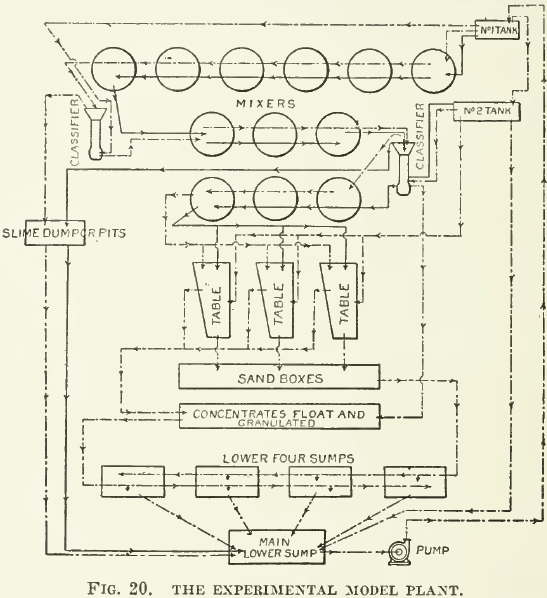
discharged from No. 9 into another upcast, where further slime- gangue was eliminated by overflow. The balance of the material was then passed to No. 10 mixer, and thence through No. 12 to the Wilfley tables. The separation on the tables was effected thus: Such concentrate as had been frothed by the aeration and agitation passed off the table immediately opposite the point of feeding. The granulated or ‘air-bally’ material remained in close contact with the table, along with the sand, but floated immediately under the influence of puffs of air (supplied through a pipe laid lengthwise and close to the table), and then floated off with the froth concentrate. The sand was delivered toward and at the end of the table, thus exactly reversing the relative positions of concentrate and tailing as ordinarily obtained if working by gravity concentration. The slime and sand were collected in one receptable and the float and granulated concentrate in another, the surplus liquors in each case flowing to a common sump for re-use.
From the first day of operation the ease with which the float concentrate could be recovered was very striking; but the separation of the granulated concentrate from the coarse sand by tabling on a large scale was found to be a very delicate and difficult operation, and it was at once evident that ‘spitz’ separation would relieve the tables. The upcasts were also continually choking and proving a source of trouble, besides sending over large quantities of slime with the concentrate, thus reducing the grade of the product and lessening its market-value.
It was therefore decided, when the plant had been running for a few days only, to construct a small rectangular spitz-box for trial. This was introduced early in August 1905, the feed to the spitz-box being prepared pulp discharged from No. 7 mixer.
It was found also, as soon as the plant started regular treatment, that the agitation was excessive, and mixers 10, 11, and 12 were cut out.
Cone-agitators made of phosphor bronze were tried, then centrifugal stirrers, but the scour both on the stirrer and the sides of the mixer, due to the impact of the sand, was so great that these had to be abandoned, although the agitation and aeration had been considerably increased.
The spitz-box in the slime-overflow circuit gave excellent results, and toward the end of August it was possible to obtain the requisite agitation by using the first six mixers only. A fresh spitz-box was placed in the position formerly occupied by vats 7 and 8, with arrangements for all tailing-flows, both slimes and sands, to deliver to No. 1 hutch of a special spitz on the floor beneath. The object of this spitz (3-compartment) was (1) to allow a settlement of the granulated material in the first compartment; (2) to effect a settlement of middling for re-treatment on tables in the second; (3) to provide for the deposition of clean sand and slime in the third, with an unrestricted overflow for the float material. Sprays on the surface of the liquor, and upcasting jets of water, were provided to assist the operation. Various simplified forms were later adopted as the process merged from partial to complete flotation, as illustrated in the experimental spitz-box for the granulation plant (Fig. 21).
At first the sand was ejected by sluicing out to a dam; but this being wasteful of circuit-liquor, and therefore also acid, it was decided to construct sand-boxes, through which, in turn, the suspended sand could be deposited—the liquor overflowing from these sand¬boxes to be run to the pump-sump and thence re-circulated through the plant. By this means a closed circuit would be secured, and liquor- losses minimized. It was not until November that these sand-boxes were actually in use. Meantime, it was noted, particularly in slime- tests, that the operation was appreciably assisted by raising the temperature of the liquor. Steam jets were, therefore, introduced into the mixers in the plant early in September 1905.
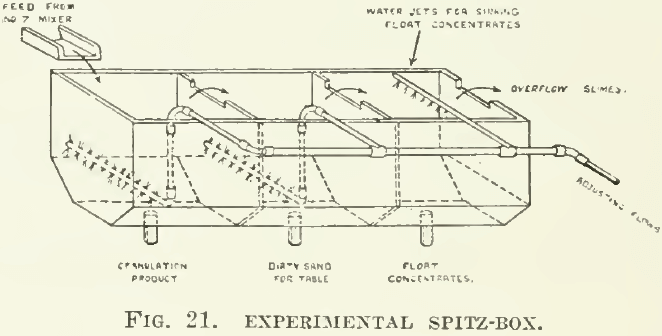
Before advancing further with the evolution of the process as developed in the first large plant, it is perhaps advisable to refer here to certain experiments that mark a most important era in the history of the process.
DISCOVERY OF THE FROTHING PROCESS
We now come to a stage when a remarkable development in the operation was discovered (strangely enough, at the same time both here and in the Patent Co.’s laboratory in London), which had for its main principle the reversal of all previous operations, and consisted in the complete flotation of each particle of mineral independently in place of granulating the mineral particles and causing them to sink, thus not only revolutionizing the process, but greatly simplifying and cheapening it. The developments noted were mainly along the line of decreased consumption of oleic acid or oil, for example, from 3% oleic on ore, resulting in very little float, down to 1%, giving practically a complete float.
The following data from a report furnished by A. H. Higgins (March 16, 1905), indicate in more detail the nature of the experiments and the effect on the separation produced by varying the percentage of oleic acid.
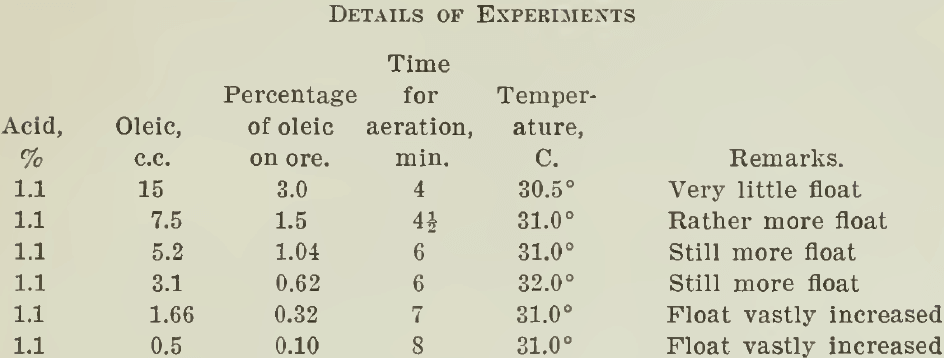
In every case the oleic acid has been measured in cubic centimetres and the percentages calculated as though they weighed grains; but, as the specific gravity of oleic is less than that of water (taken as 1), all percentages will be lower than those actually given.
These experiments obviously proved that the reduction in the percentage of oleic acid materially altered the type or character of the oiling of the mineral particles—the higher percentage producing granules, which were precipitated, while the lower percentages produced a mineral froth. As the quantity of oleic acid decreased, the time required for oiling the mineral particles and aerating them was found to increase, and more froth formed. These tests, followed by many others, led to Messrs. Sulman, Picard, and Ballot’s British patent of April 12, 1905, under which “finely powdered ore, suspended in acidified water, is mixed with a small proportion of an oily substance such as oleic acid, amounting to a fraction of 1% on the ore, and agitated until the oil-coated minerals form into a froth, which can be separated from the gangue by flotation. Heat may be applied to facilitate oiling, and either shaking tables or spitz-boxes may be used to separate the frothy mineral from the sands and the gangue slime.”
To return now to the record of operations at the large plant, some successful tests were carried out in September 1905 on dump-slime, by using this flotation method. Agitation was completed in six mixers (using cones) in 0.6 to 1% sulphuric acid at a temperature of 80-90° F. The quantity of oleic acid used in these tests was from 0.15 to 0.2% on the actual dry weight of slime treated. From the sixth mixer the pulp passed “with a good splash” to the first spitz, and the residues from this “with a good splash” to No. 2 spitz, and the tailing from this latter spitz-box was run into dams. These and other experiments emphasized the importance of dropping the pulp vertically into the spitz to assist aeration and subsequent flotation, and of heating the liquor to enhance the oiling of mineral particles.
The three-compartment spitz-box with upcast water-flows gave place, in turn, to a two-compartment spitz-box without upcast flow, and this, in turn, was replaced by a single-compartment spitz, the latter being provided with a rigid flat board on which the feed was splashed to assist aeration. Conical spitz-boxes were tried, but not generally adopted.
FROM GRANULATION TO FLOTATION
The plant had now been running for a couple of months on tailings and slimes from various sources, and during this time the frothing method was generally ousting the granulation process, until, finally, the superiority of the spitz-box and froth method was clearly demonstrated. The Wilfley tables of the original plant were then dismantled to make room for the sand-boxes already mentioned, and the granulation gave way to flotation with simple spitz-boxes early in October, after treatment of approximately 1700 tons of crude ore, tailing, and slime.
This method of working, thus briefly outlined, quickly established itself as capable of dealing with the company’s ores and by-products, and Mr. Chapman’s patent of September 1906 was taken out to protect the various discoveries made by supplementing Sulman, Picard, and Ballot’s patent (No. 5032, 1905). Under Mr. Chapman’s patent:
- The ore, suitably crushed, is agitated with acidified water in the first mixer and heated.
- Oleic acid is subsequently added in the second vessel.
- The pulp is maintained at the desired temperature in the third and following mixers, with violent agitation in each mixer to insure complete and thorough aeration. A sequence of operations is thus arranged by which the solution, after the second agitator, is practically or entirely neutralized, so that the liquor in circuit as a whole is neutral, except at the outset, when the ore is introduced.
The adoption of this flotation process with its neutral liquor allowed the use of iron where formerly, under the granulation method, with acid liquor, only wood or special metal could be used. For instance, the original wooden-cone mixers, which had been replaced by centrifugal stirrers of copper or beaters of regulus metal, were now replaced by four-armed stirrers of cast-iron.
A great difficulty lay in the grinding. The experiments had proved that the best work could be obtained on material that would pass through 40-mesh, and that practically the finer the material the better the recovery. The whole experience in the fine grinding had been with ball-mills in our magnetic plant, and accordingly a No. 8 Krupp dry ball-mill was attached to this plant as part of the equipment. The dry mill proved unsuitable, and, with considerable difficulty, it was converted to a wet mill. Even then its capacity, allowing for numerous break-downs partly due to forcing its capacity, was too limited, and two No. 5 Krupp wet ball-mills were installed to assist. Meantime, experiments proved conclusively that grinding- pans were superior in character of work, cost of maintenance, and power consumed, to the ball-mills for re-grinding tailing, whereupon we installed a grinding-plant which was gradually increased until the ball-mills were thrown out of use entirely. The character of the work was much improved, and it urns then evident how much the progress of the process to a satisfactory stage of efficiency had been retarded by lack of efficient grinding appliances.
EXTENSION OF PLANT
The operations of the first plant were commercially and technically successful, and an extension was completed, with all its appurtenances, including grinding-pans for the reduction of the material to the requisite degree of comminution, conveyor-belts for the disposal of the residues, together with bins for concentrates and tanks for storage of liquor, toward the end of 1906, at a cost of £25,000, the sum of £11,000 having been already spent on the initial experimental plant. The total quantity of material treated by this flotation plant was 135,808 tons, which yielded 45,147 tons of high-grade zinc concentrate. The plant continued in successful operation until the completion of the wet-mill zinc section, which was capable of supplying the quantity of zinc concentrate under contract. During the time this plant was in operation numerous tests were made with a view to increasing the aeration, which was recognized as the chief factor in flotation, and at the same time lessening the mechanical energy absorbed in aerating. Among these may be mentioned the nest of centrtifugal pumps, as illustrated in Fig. 22. The pumps were worked in series, each one drawing a tailing from the preceding spitz and discharging into the next succeeding spitz. The aeration and flotation wrere produced satisfactorily, but it was soon found that the scour in the pumps, caused by the gritty nature of the material being pumped, was so great that the heavy maintenance would counter-act the other advantages. Another expedient was to lift the whole of the tailing discharged from the first spitz by means of an air-lift. This also resulted in increased aeration, but it was found that the volume of liquor would have to be increased to an impracticable quantity to give the necessary velocity to carry the particles of ore, etc., up the rising leg of the pipe and prevent settling. An elevator was subsequently installed in its place to command the third spitz of the series. Further expedients were the insertion of a jet of air into a centrifugal pump used for raising liquors and material for re-treatment, the introduction of a jet of compressed air into the
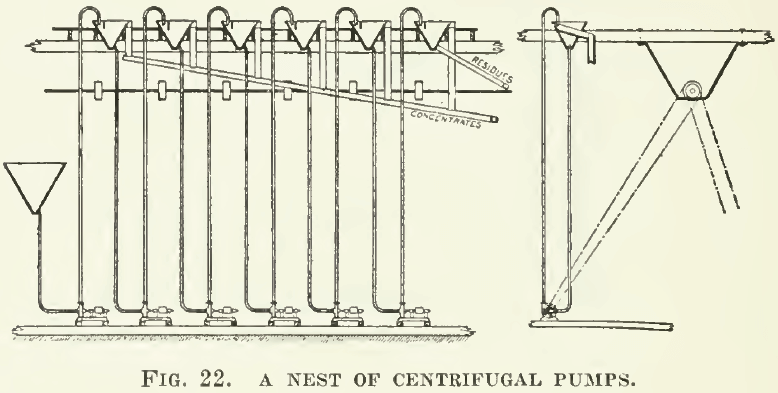
mixer-boxes, and also the insertion of pipes in the mixer-boxes in such a position that air would be drawn into the bottom of the mixer by the rotation of the blades. As a result of all these expedients, the conclusion was formed that the air, to be of value, must be finely comminuted, but that any addition was of value that would decrease the energy required to secure aeration by means of mechanical agitation.
MINERALS SEPARATION PLANT
The Minerals Separation company, owners of the froth patents, purchased the tailing-dumps on the Central mine, and, by arrangement, a plant was designed and erected by the Sulphide Corporation for their treatment. The plant is shown in cross-section in Fig. 23, and was designed on previous experience for the treatment of 2000 tons per week. It was finished at a cost of £26,000 complete. The efficiency of the grinding-pans proved so great with the new design of positive pan that the plant was able easily to handle 5000 tons per week. This plant was responsible for the treatment of 709,999 tons of tailing, etc., and the production of 242,462 tons of concentrate up to the time it was shut-down in June 1911 on the exhaustion of the dumps.
In connection with the Minerals Separation plant, it is important to note that the fact of the circuit being no longer acid, but neutral, has been taken advantage of, inasmuch as there is only one circuit through iron grinding-pans, agitators, and spitz-boxes. The original granulation plant, being designed for an acid circuit, was equipped originally with wood throughout where liquor circulated, and with dry-crushing ball-mills for the same reason. Later, wet crushing was adopted, but with a fresh-water circuit, kept carefully separate from the acid circuit in which the actual separation took place. The successful development of the flotation process, however, has enabled both crushing and separation to be conducted in one and the same circuit, and has thus greatly simplified operations.
The liquor that was circulated through the Minerals Separation plant was approximately 25,000 gallons per hour. During the course of operation, therefore, over 600,000,000 gal.—equal to nearly 3,000,000 tons—has passed through the 12 iron grinding-pans of this plant without detrimental effect. No stronger evidence could be produced as to the freedom of the circuit-liquor from acidity. The maintenance charges on these iron pans are no heavier than corresponding charges on exactly similar grinding-pans in the lead- mill crusher-section, where fresh water only is used.
Following exhaustive experiments in the laboratory, various media have from time to time been used for long periods on the commercial scale, both in substitution for and in combination with oleic acid. Chief among such media are amyl alcohol, resin-oil, camphor-oil, pine-oil, and eucalyptus, with all of which ingredients good work has been obtained. Thus Nature, in close proximity to the vast bodies of complex ore, has provided the means for the concentration of such ores, for the essential oil of the Australian eucalyptus is one of the best-known media available for the successful exploitation of refractory Australian ores. It is of interest to note here that this application of an Australian product to the treatment of complex ores is the outcome of a research on the Central mine by an Australian metallurgist, Henry Lavers; and it was also in the milling-plant on the Central mine that eucalyptus oil was first used on a commercial scale for concentration by flotation.
This satisfactory stage having been reached, attention could now be turned to improvements in methods of handling, and, on suggestions from the owners of the patents, it was found that, by connecting the bottom of each spitz-box with the bottom of the next mixer in series, that all the spitz-boxes could be kept on one floor, thus improving the supervision of the work. An experimental plant of this nature was erected at the end of our No. 2 zinc section in September 1910, and, proving highly successful, the system was altered with confidence to this method of working. Experience shows that, for ideal work, the feed material should all pass through 40-mesh, but it is impossible to secure this condition of grinding at all times in the mill, as designed. Moreover, although the Sulphide Corporation was quite aware that improvements in character of plant and methods of operation generally were easily possible, their attention, by force of circumstances, had to be turned sedulously to increasing the production with the appliances at hand. As illustrating what the writer means by ideal grinding, the records of the average assays of residues show continually that where the average in zinc is from 2 to 2.5%, that portion remaining on 40-mesh will assay from 3 to 4% zinc. As illustrating the character of feed, and proving that the process is capable of handling successfully the very finest material, sizing-analyses by commercial screens of the feed to the zinc-section, zinc-concentrate as shipped, and de-leading plant lead-concentrate as shipped, are given:

RESULTS OBTAINED
For comparison with the work of the old mill, the following summary of results achieved by the existing plant will be of interest. This table summarizes work done on a commercial scale in the Central mill over a period of twelve months, ending December 28, 1912, and demonstrates conclusively the vast improvement in concentration practice made possible by the adoption of the flotation process.
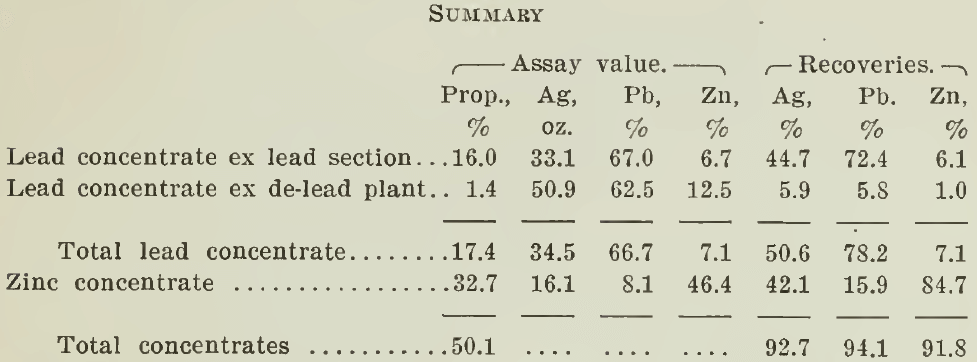
Modifications of the wet mill are now in hand for the improvement of the grinding, but it is felt that, as the proportion of lower-level ore increases, the grinding appliances will have to be increased in order to allow for the finer crystallization of the minerals in the ore as further depth is attained. The writer is of opinion that the figures quoted clearly show that if the ideal grinding is obtained the already high recoveries of metals will be further augmented.
It is unique in the history of concentration that so far-reaching and extensive a development should have reached its present state of perfection in so short a space of time, and more wonderful still that it should prove applicable in an equally masterly manner to so many other classes of ore. There can be little doubt left in the minds of those who have seen this new system of concentration that it must of necessity spread to all parts of the world.
https://archive.org/stream/flotationproces00unkngoog#page/n124/mode/2up
